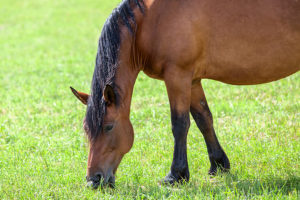Evaluating Horse Diets: What to Know

Nutritional evaluations take the guesswork out of whether your horse consumes a balanced diet
Your horse has a shiny coat and has never had issues maintaining weight. The 2-year-old in the next stall is growing steadily into the reining prospect of her owner’s dreams. And the barrel racer across the barn aisle performs well and always recovers from competition quickly.
It’d be easy to assume each of these horses is fueled by a well-balanced nutritional plan, but making assumptions in the diet department can have serious consequences. That’s where nutritional evaluations—making sure the diet is supplying all the necessary nutrients—are key to keeping horses healthy.
We consulted two equine nutrition specialists to learn what you need to know about deconstructing a horse’s diet to ensure he’s getting what he needs to thrive.
Do All Horses Need Nutritional Evaluations?
“A nutritional evaluation can determine if a horse needs additional nutrients or if some nutrients are in excess of needs,” says Laurie Lawrence, PhD, a professor of equine nutrition at the University of Kentucky, in Lexington. “With that knowledge, the owner can make adjustments to the amount or type of feeds that are in the ration.”
All horses benefit from occasional nutritional evaluations and resulting ration adjustments. But, our sources agree, certain equine classes—including those with health problems or that are competing, growing, or breeding—should have their diets assessed and balanced on a more regular basis.
Take the growing horse, for instance. “Most of us want to develop a horse into an athlete, or at least something that’s going to be healthy and have longevity,” says Brian Nielsen, PhD, MS, PAS, Dipl. ACAN, a professor of equine nutrition and exercise physiology at Michigan State University, in East Lansing. “To do that you have to be certain you’re feeding the appropriate nutrition.”
It’s not just ensuring the horse is consuming enough calories. Growing horses need a specific mix and quantity of nutrients in their diets to ensure their bodies grow and develop properly.
“And here’s the tricky thing with nutritional deficiencies: A lot of them aren’t things you’d see acutely,” Nielsen says. “In other words, they typically develop slowly, and you might not notice it happening at all. Some mineral deficiencies can take years to become a significant problem.”
The calcium to phosphorus ratio is important in diets for growing horses, Nielsen says; diets with less calcium than phosphorus can put youngsters at risk for issues such as osteopenia, or decreased bone mass. This, in turn, can result in enlarged joints or crooked long bones, which can ultimately increase the horse’s risk for injury or mechanical breakdown as he ages and enters work.
Similarly, study results have suggested dietary copper deficiencies can put growing horses at increased risk for developing potentially performance-limiting osteochondritis dissecans (OCD) lesions.
It’s not just the vitamins and minerals that can cause issues. Simply feeding growing horses too many calories without adequate amounts of other nutrients can promote rapid growth, which can put them at a greater risk for developmental orthopedic disease than a youngster with a more consistent growth rate.
“You could essentially set your horse up for some long-term health problems by not evaluating the diet,” Nielsen stresses.
Broodmares need not only enough calories to support themselves and their growing fetuses or foals but also the right balance of nutrients to give their offspring a good start in life. Horses working in high-intensity sports might have different electrolyte needs than pleasure horses. And horses with certain health issues might need custom-tailored diets to keep their bodies functioning properly. For instance, researchers know horses with the muscle disorder type 1 polysaccharide storage myopathy (PSSM1) need a low-sugar and -starch, high-fat diet to help prevent excess levels of glycogen and an abnormal type of polysaccharide (a form of carbohydrate) from building up in muscle tissue.
“But, even for happy and healthy horses, an occasional nutritional ‘checkup’ is a good idea,” Lawrence adds.
For instance, protein and associated amino acid deficiencies can result in weight loss, poor hair and hoof quality, and muscle mass loss. Excess dietary selenium—a trace mineral to which equids are incredibly sensitive—can cause signs of colic, increased heart and respiration rates, head pressing, and even death in otherwise healthy horses.
The key point: While certain classes of horses might benefit from more regular dietary evaluations, it’s an important part of maximizing all horses’ health.
Evaluating the Diet Step by Step
“A basic evaluation compares the nutrients that a horse is consuming to the nutrients that horse needs,” Lawrence says.
So, the first step in evaluating the diet is to determine what the horse eats each day.
“That’s a very simple task, right?” Nielsen says. “But here’s the issue: Many owners will probably tell you, ‘I feed two scoops of this 12% feed.’ They probably don’t know how many pounds of feed that is.

“Plus,” he adds, “many owners might not think to include forage in the evaluation. And, if they do, they often tell me the horse gets two flakes of a mixed-grass hay and is turned out on pasture. That doesn’t really tell me a whole lot about what nutrients the horse is actually getting.”
The good news, Lawrence says, is it’s not hard to reach a fairly accurate estimate of what makes up your horse’s diet, particularly if they are fed individually in stalls and have limited pasture access.
“The easiest way to do that is to weigh the amount of hay and concentrate that the horse is getting each day,” she says. “It doesn’t take fancy equipment, just a bathroom scale (a fishing-type scale works, too), a bucket, and a large garbage bag.”
If you don’t have a scale with a tare button/adjustment, weigh the empty bucket before adding the amount of concentrate the horse gets each day; subtract the weight of the bucket to find out how many pounds the horse eats. Then, place the horse’s daily hay ration in the garbage bag (or a haynet) and weigh it; a garbage bag probably won’t affect the numbers too much, but a haynet could weigh a pound or two, so use your best judgment on whether to determine its weight separately and subtract it from the total.
One point to remember: “You may have to make an adjustment on the amount of hay consumed if your horse doesn’t consume all that is offered,” Lawrence says.
If your horse consistently leaves forage behind, consider weighing what you offer, then weighing his leftovers to determine how much he consumes. Doing this over the span of a week or so and finding the average amount consumed can give you a good working number to use in your evaluation.
“If your horse is out on pasture, intake will be much more difficult to estimate,” Lawrence says. “The amount of time in the pasture, as well as the composition and density of the plants, will affect intake.”
She says access to a sparse field for a few hours each day likely won’t contribute much nutritional value to a horse’s diet. But longer turnout on lush pasture is a different story.
“Then, intake could be pretty high,” she says. “Some estimates suggest that during one hour of grazing on lush pasture, a horse can ingest the equivalent of 1 to 3 pounds of hay.”
Once you’ve determined what your horse consumes each day, it’s time to evaluate which nutrients are in his feed. Be sure to include supplements in this step, as some can alter the diet’s balance significantly.
“This part is straightforward for most commercial feeds, and the feed tag/bag should have information about the nutrient content,” says Lawrence. “Manufacturers are usually happy to supply information on nutrient content beyond what is on the feed tag,” so reach out to the feed company if you have a question.
Likewise, most supplements have nutritional information on their packaging, and many manufacturers can supply additional information upon request.
Our sources agree that the diet’s forage component is the most complicated part of this step of the evaluation.
“The best way to determine nutrient content of a forage is to obtain a representative sample and have it analyzed” at a commercial or university laboratory, Lawrence says.
It’s a relatively inexpensive endeavor, Nielsen says, and you typically receive results in a few weeks.
“Sometimes it makes sense to do that, but, practically, there are times when it doesn’t really make sense,” he adds.
If you produce your own hay or buy enough hay (ideally grown in the same fields) to last six months or a year from one seller, “it makes a whole lot of sense to get it analyzed,” he says.
“But if you buy 20 bales at a time from the local hay auction or retailer,” Nielsen continues, “by the time you send off samples and get results from one batch of hay, your horses have eaten it all and you’re on to the next one.”
In those cases, or if sampling and analyzing hay isn’t an option, “textbook” reference values for different forages can give at least an estimate of what the products your horses consume might contain, Lawrence says.
“I typically go to Equi-Analytical’s website, which lists the average concentrations of various nutrients from the huge number of samples they analyze,” Nielsen says.
Next, it’s time to get out your calculator to determine nutrient intake.
“Nutrient intakes are calculated as feed amount times nutrient concentration,” Lawrence says. “For example, if a horse is receiving 10 pounds of hay and the hay contains 10% protein (10 x 0.10), the horse is consuming 1 pound of protein via hay each day.”
You’ll need to determine how much of each nutrient your horse is consuming to complete the final step, which is comparing his intake to how much he needs. This is based on his weight, activity level, and whether he needs to gain, lose, or maintain weight, Lawrence says.
“There are several feeding standards that have been developed in different countries and by some feed companies for horses,” she explains. “In the U.S., the National Research Council’s publication Nutrient Requirements of Horses is a common resource.”
An online calculator containing the same information as the publication can help streamline the evaluation process, she adds.
Evaluation Complete. Now What?
The analysis might be done, but the work isn’t over. Now it’s time to translate the results into practice.
“Once the evaluation is complete, owners can make diet adjustments if the horse’s needs are not being met or if some nutrients are being fed in excessive amounts,” Lawrence says.
An equine nutritionist or a veterinarian trained in equine nutrition can help refine the diet based on the evaluation results to ensure the horse is consuming the nutrients he needs to stay healthy at the appropriate level, Nielsen says.
“I love straight forage diets,” he says. “If you can get by with it, I think it’s absolutely phenomenal. But I also recognize that many forages aren’t going to meet all horses’ dietary requirements.”
On the other hand, pricy supplements and feeds that can benefit some horses might, for others, have little to no dietary benefit, he adds.
“People spend so much money on supplements and grain because they’re so concerned about their horses’ diets,” Nielsen says. “But they won’t spend any money to bring somebody in to do a quick analysis. A lot of times you can save a lot of money and potentially avoid some long-term health problems. It really does behoove you to go ahead and have an evaluation done, both for the benefit of your horse’s health and your bottom line.”

Written by:
Erica Larson
Related Articles
Stay on top of the most recent Horse Health news with















